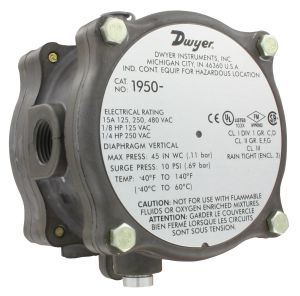Dwyer 1950-5-2F differential pressure switch is used to measure and control pressure differences between two points. It is specifically designed for applications where the pressure range falls between 1.4 and 5.5 inches of the water column.
Features:
- Dwyer 1950-5-2F differential pressure switch has an explosion and weather-proof housing to protect it from harsh environmental conditions.
- It has a simple electrical connection that makes installation easy.
- This differential pressure switch has a set point screw that provides easy adjustments without disassembling the enclosure.
- It has an operating range of 1.4 to 5.5 inches of the water column.
- This Dwyer Instruments 1950-5-2F differential pressure switch has explosion-proof and weatherproof housing to sense a difference in pressure between two pressure sources.
- It is equipped with an external set point screw for providing easy access to simplify making adjustments without opening or disassembling the enclosure.
- This Dwyer differential pressure switch is CE, UL, CSA and FM approved for use in Class I, Div 1, Groups C & D; Class II, Groups E, F, & G; and Class III hazardous atmospheres (NEMA 7 & 9), Raintight NEMA 3 (IP54).
Standards and Approvals:
Frequently Asked Questions:
Q. What is the operating temperature range of this device?
A. -40 to 140 degrees Fahrenheit.
Q. Is this device compatible with combustible gases?
A. No, Dwyer 1950-5-2F differential pressure switch is compatible with air and non-combustible gases only.
Q. What is the mounting orientation of this switch?
A. Dwyer 1950-5-2F differential pressure switch can be mounted in any orientation as long as the diaphragm stays vertical.
Q. How do I set the setpoint on a differential pressure switch?
A. Differential pressure switch has a dial mechanism to adjust the setpoint.
Q. How to maintain Dwyer 1950-5-2F differential pressure switch?
A.
- Regularly inspect and clean the pressure ports to prevent clogging or debris buildup.
- Check and calibrate the setpoint periodically to ensure accurate operation.
- Verify electrical connections for tightness and proper functioning.
- Protect the switch from extreme temperatures, moisture and corrosive environments.



